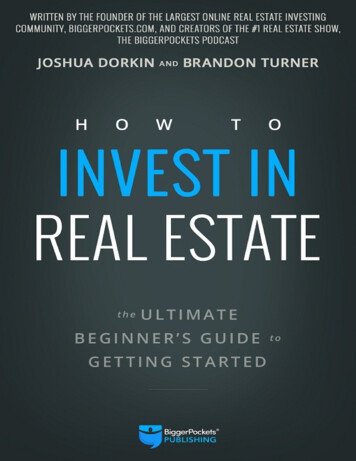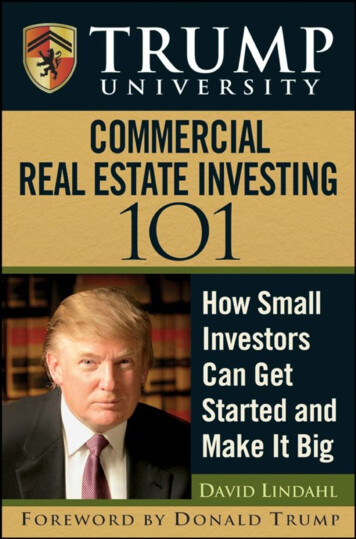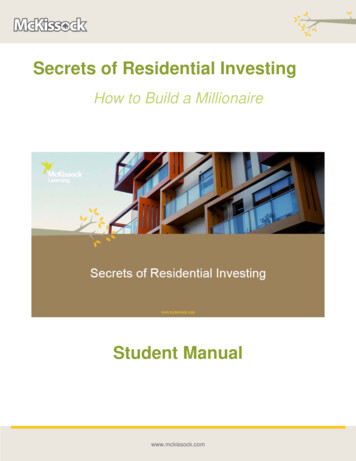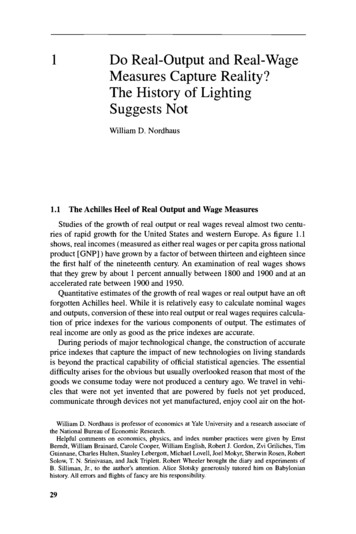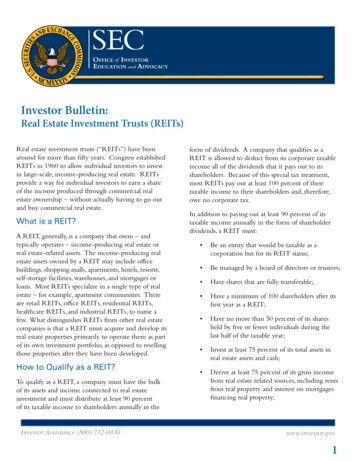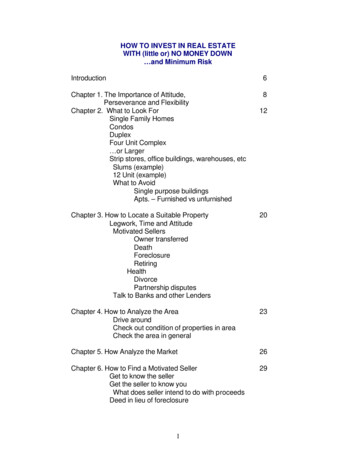
Transcription
HOW TO INVEST IN REAL ESTATEWITH (little or) NO MONEY DOWN and Minimum RiskIntroduction6Chapter 1. The Importance of Attitude,Perseverance and FlexibilityChapter 2. What to Look ForSingle Family HomesCondosDuplexFour Unit Complex or LargerStrip stores, office buildings, warehouses, etcSlums (example)12 Unit (example)What to AvoidSingle purpose buildingsApts. – Furnished vs unfurnished812Chapter 3. How to Locate a Suitable PropertyLegwork, Time and AttitudeMotivated SellersOwner rtnership disputesTalk to Banks and other Lenders20Chapter 4. How to Analyze the AreaDrive aroundCheck out condition of properties in areaCheck the area in general23Chapter 5. How Analyze the Market26Chapter 6. How to Find a Motivated SellerGet to know the sellerGet the seller to know youWhat does seller intend to do with proceedsDeed in lieu of foreclosure291
Chapter 7. How Analyze the PropertyGathering InformationAnalysis Program (IPP)33Chapter 8. Ways to Finance the Property39Understanding how a mortgage worksSeller financing (#1 choice)No closing costs on mortgageMore flexible on terms and ratesMore motivated to negotiateTalk to Banks and other LenderUnderstanding how lenders workBe prepared for rejectionHave your presentation readyProperty DetailsYour Financial StatementProperty Financial statementIntended improvements and costsMarket detailsPhotos of propertyYour track record (if you have one)Bank discounting their mortgageInterest moratoriumPayment moratoriumExtend term of mortgage to reduce monthly pmtsFinancing AlternativesNormal Amortized loanInterest only mortgageAdjustable rate mortgageGraduated payment mortgageBalloon mortgagesWraparound mortgage or(all inclusive deed of trust)Land leasesCombine financing approacheswith multiple mortgagesSale/LeasebackAssume seller obligationsCautions on FinancingTerm of loan and balloonsGraduated interest ratePre-payment penaltiesNon-assumable loansLoans assumable at a revised interest rate or termsNo pre-payment allowedVerifying present mortgage balance and terms2
Chapter 9. The Importance of Using LeverageHow much leverage is advisableWhen should you pay off a mortgageMultiple mortgages51Chapter 10. Where to Locate Cash58Family and FriendsBanksPrivate LendersMortgage BrokersMortgage BankersCredit CardsSell off part of the propertyRefinance another propertyBorrow against life insuranceBorrow against stocksPersonal Loans from bankHome equity loan (use caution)Add closing costs into mortgageGive something in lieu of cash (car, boat, stock)Escrow, advance rents, etc. as part of down payment (caution)Trade equity in another property you own for down paymentTrade for anything you have that they wantSell a mortgage at a discountChapter 11. How to walk away from the closing62with nothing downand cash in your pocketBuying a below market value and finance big(negotiate with lender or seller)Chapter 12. Understanding the VariousTypes of OwnershipLease/OptionJoint VenturesPartnershipsCorporate ownership64Chapter 13. How to Negotiate with the Seller67Start renovation before closingPay more for the property for concessions you needLower interest rateExtend term of mortgageSeller RefinanceSell mortgage to a third person3
Chapter 14. How to Create a “win-win” situation with a Seller71Chapter 15. How to Negotiate with a LenderList and cost of intended renovationPhotos72Chapter 16. Understanding Closing Costs andClosing Statements74Chapter 17. What to Expect at the Closing78Chapter 18. How to meet expenses on your new propertyGenerating incomeShould you have leasesFlipping the property80Chapter 19. When and Why You Need to Sell the PropertyEquity too greatProblems with property82Chapter 20. The Importance of Record KeepingIncome receivedExpenditures for renovationCarrying costs on propertyNormal property expensesValue of your “sweat equity”86Chapter 21. How to Avoid Taxes on the SaleExchangingRefinancing for cash88Chapter 22. What to do if You Make a Mistakeand the Investment FlopsDeed in lieu of foreclosure92Chapter 23. The Secret to Pyramiding(not the ones in Egypt)954
Appendix:Thirteen Steps to a SuccessfulNo Money Down Investment98Case Studies: How to Put it all TogetherThe “slums” - turning a bad propertyinto a good investmentThe 12 unit apartment complex –motivatedseller but a good property101104Forms, Checklists, Sales Contract107FSBO Website Links122About the Author1275
HOW TO INVEST IN REAL ESTATEWITH NO MONEY DOWNIntroductionYou’ve no doubt seen the "infomercials" or attended a seminar or bought abook or course on "How To Get Rich In Real Estate With No MoneyDown". Unfortunately, most of the "no money down" promoters havegotten rich by selling books, courses and tapes on how to do it. A fewyears ago, a "get rich quick" guru boldly stated, "Put me in a strange citywith only 100 and I’ll own a million dollars worth of real estate in oneweek or less". and he probably was able to do it. Unfortunately we didn’tsee what happened to his investments after he owned them for a few monthsor year.You CAN find investment properties that can be bought with no moneydown. There are lots of them out there, if you know where and how to lookfor them and how to negotiate the deal.The real question is not "Can you buy property with no money down" but,"Can you afford to buy a property with no money down"? That’s somethingmany of the "no money down" promoters fail to tell you. It is, however,something you will learn here, and must learn before you try it.I spent several years on the real estate investment seminar circuit. When themarket became flooded with no money down seminars, they all droppedout. (By then, many of them had made a killing selling books, seminars andtapes). I also had a thirty-minute infomercial running on TV stationsnationwide. I’ve been part of that program and I know how they operate.Now a new batch of investment gurus have enter the market, doing thesame thing. My approach was different, however. I devoted my efforts andexperience in showing investors how to become wealthy in real estate withthe least amount of risk possible. The others have come and gone, but RealEstate Investments And How To Make Them has been highly successfulsince 1982, with several fully revised editions.Don’t get me wrong, there were some No Money Down promoters who dida fair job of getting you on the right track.but others were just in it for themoney. You can make a lot of money by investing in real estate withlimited cash. I say "limited" because, no matter what others say, you stillneed some money, even in a no money down purchase. I’ve learned theright way and about a quarter of a million readers of my book andinvestment course participants have either made a lot of money or at leastknow the right way to do it once they get started. You can even make abundle by investing in real estate with no money down. But you have to6
know how to avoid getting into financial trouble. That’s what this bookis all about.Our Real Estate Investments and How to Make Them course and softwareprogram (www.investmentre.com) offers a complete beginning to endprogram that even professional real estate investors use as a guide. This NoMoney Down ebook contains full details on the subject that is not coveredin the main book.One final point: Buying a property with "no money down" generally is noteasy. It takes work, perseverance and a thorough knowledge of what you aredoing and that is where we are going to start. This course furnishes youwith the knowledge to get it right the rest is up to you. The rewards makeit all worthwhile. As you wade through this material you will no doubt besomewhat confused or overwhelmed with the information. Don’t let thatbother you. By the time you finish reading, the pieces will all fit togetherand you will understand how important each section is to your financialsuccess in real estate investing. Once you discover the wealth ofinformation here and how important it is, you will be able to use this bookas a reference manual to get ideas you may need for a specific problem yourun into when trying to purchase a property. What is important is that youstick with it from beginning to end so you are at least aware of the variousfactors and situations that result in a successful and profitable real estateinvestment portfolio.So, if you are ready, turn the page and take a trip through the world of realestate investing when you have little or no money to invest.7
Chapter OneThe Importance of Attitude, Perseverance and FlexibilityWouldn’t it be great if you could just drive down the street of a high qualityneighborhood, see a for sale by owner sign on the property and decide this is thehouse you want to buy. You knock on the door and discuss the property with theowner. The owner says, “Yep, I need to sell so I have it priced 25,000 below fairmarket value. In fact, I want out so badly, I’ll even carry a mortgage with no moneydown”. And this was the very first house you looked at.OK, back to the real world. That will never happen at least with the first home youlook at or probably ever. Forget about what you may have heard from the promotersof “get rich quick and easily with no investment”. In this e-book, we are going todiscuss how you can and no doubt will get wealthy, but forget the “quick” and“easily” part of that last sentence. In the introduction I mentioned that you CAN buyproperties with no money down. The question is, “Can you afford to buy a propertywith no money down”? As you progress through this program, you’ll discover howthe real professionals in the business do what you want to do. The differencebetween them and the no money down promoters, is they approach a potentialacquisition knowing exactly what to expect, not just on the day of closing, but afterthey own it and are faced with 100 or 110 percent mortgages, operating expenses andno incoming coming in on the property.To be successful in this type of real estate investing, you need to accept three basicpersonal philosophies:Attitude, Perseverance and Flexibility. If you still believe you can, without mucheffort, locate, buy and sell a property at a profit, you will not doubt either make ahuge financial mistake or get discouraged and drop the whole idea of investing in realestate.Let’s begin with Attitude. You’ll need to accept the fact that, although you can locateand buy real estate with little or now cash down, it probably will not come easy. Ifyou do find a large selections of “bargain” priced property in a certain area, you’dbetter check it out carefully. Find out what those sellers know that you don’t know.More on this later. You need to have the attitude that “I spent the whole day orweek looking at properties and did not find one that meets the standards in thisbook”. Your response must be, “That’s alright, and I’ll find one tomorrow or thenext day. I’d rather wait until the right one comes along than make a mistake thatcould put me in deep financial trouble”.Let me digress a little and tell you about an investor I worked with a few years ago.It was a young couple and she was expecting their first child. He has inherited a fewthousand dollars and decided to venture into a real estate investment. He wanted arental apartment building. I feel partly responsible for what happened because in my“Real Estate Investments and How to Make Them” course I talk about making themaximum use of leverage by buying the largest property you can with the cash you8
have available. It is, however, tempered with how comfortable you are with a highlyleveraged or financed property and in knowing what you are doing. (Exactly whatyou will learn here).He fell in love with a 32-unit apartment complex that was over ninety percentleveraged. We prepared a property analysis, and it would make financial sense, evenwith that large of a mortgage. I had shown him smaller properties, eight to sixteenunits in size, but he wanted the big one. I even mentioned that this particularproperty was not in the best area of town, but that didn’t bother him either.About a month after closing, he began to have financial trouble. I was on the phonewith him daily trying to help him, but he was doing it his way. He had a couple oftenants who were throwing “pot” parties at night and disturbing the rest of the tenantsin the building and still he did nothing. I suggested he would be wise to hire amanagement company to run the property. It would cut into his income, but at leastthere would be some knowledgeable management there. Unfortunately, themanagement company he hired was even worse. All they did was collect a monthlymanagement fee for doing virtually nothing but collecting rents and paying bills. Oh,they also talked him into spending more money to improve the property.Unfortunately, they did nothing to solve the real problem the undesirable tenants.It wasn’t long before the decent tenants started moving out, leaving him with a hugemonthly debt and not enough income to cover it. He finally ended up losing theproperty.Back on our subject, this is the reason you need to accept the attitude that it is betterto wait for the right property than it is to jump into one that will put you in financialdifficulty.This brings up the second of the three philosophies: Perseverance:If you are not willing to wait and continue searching until the “right” property comesalong, then do yourself a favor and wait until your rich uncle dies and leaves youenough money to make a reasonable down payment on an investment property.Let me inject a thought here: In this book, we are concentrating on how to buy a realestate investment with little or no money down out of your pocket. Generally, this isthe position many investors are in when they want to buy that first property. Onceyou have that first one up and running and appreciating in value through fixing itup or flipping it, you now have some cash to work with on the second one. Eachproperty you purchase after that first one becomes easier and easier, because you nowhave some cash equity to work with. In Chapter 24, we discuss the practice of“pyramiding” and how you can use that initial property investment and build it into alifetime estate, without ever adding any money.9
The important thing to realize that the first property you buy is the most difficult.Not only is it the one that is extremely highly financed, but also you are justbeginning the investment process and may not be too sure of what you are doing orhow to do it. That’s what you will learn as you wade through this book.So, don’t be discouraged if it takes you a week or a month to locate that firstproperty. You are better off continuing to look until you are comfortable with yourselection than to try to get out of one you should not have purchased to begin with Perseverance is the key to sound real estate investing. I’d hate to estimate how manyinvestment property I usually show, even a professional investor, before he or shedecides, “This is the one I want”. They already know the rule of perseverance withthe attitude, “The right one will come along sooner or later if I just keep looking. Imay lose one or two during the search, but that’s alright. Another better one may bejust around the corner.”Perhaps I should qualify that last statement a little. I’ve worked with investors whowere so hung up on the idea that “a better one will come along if I just wait” that theynever invested at all and that’s an even bigger mistake than buying a property thatmay not be entirely perfect in their minds.The final philosophy you need to accept is Flexibility. You may have an idea in yourmind that you will look at only homes priced at under 100,000 but they have to bein a neighborhood where home are all priced at 150,000 or higher. Chances aregood you’ll never find one. Maybe you are hung up on a home, but the only thingthat is available, in your price range and terms of purchase you require, is acondominium or town-home in a maintained community. If the numbers make sense,and you do your homework, it may be a good place to start your real estateinvestment program.Important Point: Real estate investors buy “money making machines”, nothing moreand nothing less. I’ve had investors make the statement, “No, that’s not acceptable.I wouldn’t want to live there”. Of course not, we’re looking at a 100,000 house andthey live in one valued at 250,000. You need to look at it from the perspective of atenant. How does it compare with other, comparable apartments or homes in thearea? Not everyone can afford a quarter of a million dollar home. But they still needa place to live that is affordable, clean and in a decent neighborhood. That’s whatyou can offer. As you progress through this book, you will learn how to analyze theproperty, the neighborhood and the market.Never lose sight of the fact that you are buying a money making machine. One goodenough to attract tenants, whether it is a home, a store, a warehouse or whatever andwill bring in enough income to make your investment grow and get you startedtoward creating a sizable financial estate for yourself. Later we’ll discuss the factthat you are only going to keep this property for a certain length of time anyway.10
You need flexibility to accept whatever type of investment property is available thatmeets you requirements at the time you are ready to buy. The worse mistake you canmake is becoming discouraged or in flexible that you never buy anything.So, now that you are convinced (you are convinced, aren’t you?) that you need to getstarted in a real estate investment even though your cash is limited or non-existentand the property you’d really like to own is also non-existent, it’s time to go propertyhunting.11
Chapter TwoWhat to Look For in a PropertyThroughout this book we will assume that you are trying to buy an investment realestate property with no money investment on your part (or very little, at best). Keepin mind that current market conditions and availability of product may effect youchoices.Single Family Homes: The most common type of “first” investment for mostinvestors is a single-family house. There is generally considerably more of aselection and all areas and price ranges. So, what price range are you in? It’s kind ofa vicious circle it’s whatever is available at the time you are looking, and thatmakes financial sense. Single-family homes are the easiest to manage andunderstand. Chances are you own one now that you are living in, so you know whatto expect as far a expenses, potential rents, etc.We need to stop here, for a minute, and discuss income an expenses. In Chapter 7we’ll discuss how to analyze a property to insure it makes financial sense for you.You already know that, unless you intend to fix up a property (or not even botherfixing it up) and flip it or sell it, you need to create some income in order to offset theexpenses. (Again, we’ll cover this subject in detail later).When looking at the property, you need to consider how much rent you could get, ifyou leased the home, and if it will be enough to cover the expenses and mortgageprincipal and interest payments.Single-family homes are the best place to begin your search. You have several waysto do it:1. Drive the neighborhoods that are of interest to you. Look for FSBOs (ForSale By Owner) signs. Look for signs of poor maintenance on the home andgrounds. This is often a sign of an owner having some kind of problems.You may even contact the owner of an obviously run down home, even ifthere is no for sale sign on the property. He or she may be willing to sell.Hint: Don’t be afraid to talk with property owners. This is what stops many wouldbe investors from buying. They just can’t face talking to a stranger about sellingtheir home. When you find someone who needs to sell, they will usually be morethan happy to talk to anyone who may want to buy. Their first question to you willprobably be, “Are you a real estate broker”? You’ll win a lot of points by tellingthem you are not. You are not there looking for a listing. You are very interested inpurchasing their home.Help: We furnish you with a set of checklists with this program. You can print themout and use them to remind you what to look for when considering a property andwhat questions you need to ask the seller. You should always take these lists with12
you when looking at a property or talking to a seller. It also makes you look a littlemore professional and serious about buying a home.2. The second possible source of homes for sale is the homes for sale section ofthe classified ads in your local newspaper. You’ll need to call the seller andarrange to see the property. You can generally obtain an address and sellingprice over the phone. (Real estate brokers are taught NOT to give thisinformation over the phone because a potential buyer can then drive by thehome and, without seeing it on the inside, decide it is overpriced.)The first question you will probably again be asked when you call is, “Are you areal estate broker”? They have no doubt already been bombarded by thirtybrokers calling trying to get a listing.Your goal, however, is to find out four things (all of which are covered in detaillater)A. What is the neighborhood like? It is in a good neighborhood?B. What does the home look like? If it is in good condition, and comparablewith other homes in the area, chances are you will not be able to make a dealwith the seller. This should not stop you from trying, however. You knowthe price (the seller told you that when you called him). You’ve also doneyour homework, so you know what homes are selling for in the area. If thereare some real estate broker signs on other properties, call them and try to getas much information as you can, especially price, terms, number of bedroomsetc. Use your checklist to cover the main items.C. What are current market conditions? Are there a lot of homes on the market?If so, you may have a shot at this one, assuming the owner needs to sell.D. Since you want to rent it, if you buy, how much rent can you expect to get.What are other rentals going for in the area? (It may be difficult finding ahouse being rented, but they are usually a few).The more you know about these four areas of necessary information, the betterequipped you will be to make a sound investment decision.3. The Internet. There are a lot of individuals who will take out a web pagethrough their ISP (Internet Service Provider) and list their home on that page.It not only gives them a wide exposure of potential buyers but also is moreconfidential than a sign on the property where every broker in town and everynosey neighbor is calling them. And, it’s usually free. The Internet ad willalso give you details on the property, a photo, and the owner’s name andaddress.You can search for homes on the Internet by typing key words in whatever searchengine you use (MSN, Google, Yahoo, AOL, etc.). You’ll need to narrow yoursearch, however. If you just type in Homes for Sale, you’ll no doubt get severalhundred thousand possible websites. That’s right, several hundred thousand. So,narrow your search down to a city and state. You’ll still have more websites than13
you care to chase down. You will, however, run into some sites that specialize inlisting FSBOs. When you reach their home page they will often allow you topinpoint a city, state and even area within the city for your search. You can usuallyput is a price range as well. It’s easy to stay at home and browse potential homelistings and select only the ones that are of interest. Included with this course is apage of about 80 FSBO websites you can search for available properties.4. Bulletin Boards: Quite often, local supermarkets have a bulletin boardavailable to put your haves and wants. Put a little 3X5 card on the boardstating that you are in the market to purchase a home in the area. Give theprice range and your phone number. You may also add a line that says, “I’ma serious buyer, not a broker”. I hate to pick on brokers this way (I’ve beenone for thirty years), but sometimes we are our own worst enemies by drivingsellers crazy trying to get listings.5. Bank Foreclosures: Although we cover this subject later, it also fits in here.Contact local banks and request a list of residential property foreclosures theyare holding. These are properties they have taken back, usually throughmortgage payment default on the part of the homeowner. In Chapter 8, we’llcover how to negotiate with lenders. Sometimes you can get a great deal.Point of Interest: Several times during this book I’ll remind you to two veryimportant points about banks and REO or real estate owned. Point number one:Banks, generally, do not want to own real estate. In fact, most major bank buildings(with their name is eight foot high lighted logos) do not own the buildings they arein. They are “signature tenants” who lease enough space from the building owner(s)and are important enough tenants that they get their name spread across the top of thebuilding.Anyway, banks usually do not want to own real estate. They make their money bylending it out at a higher rate of interest that they pay their depositors. Point numbertwo: When they have to foreclose on a property, not only are they not collectingpayments on that loan, but they are forced into managing an empty house, until it canbe sold. Most banks are not in the property management business. This often makesthem quite willing to negotiate with a potential buyer sometimes for less than theamount of their mortgage.Important Point: While we’re at it, let me throw in one additional point aboutnegotiating with the bank. This point will also be repeated when we talk aboutgetting financing.Don’t be afraid to talk to the bank loan officer, or even the president. Most of us feelthat bankers live in the big ivory tower and are unapproachable. While we dress in asport shirt and slacks, bankers are dressed in dress suits, white shirts and ties and sitin a big, wood paneled office with furniture better than what we have in our homes.Don’t let this bother you. Banks are a business just like any other business. Theyhave a product or service to sell, money and they must sell it to stay solvent. If youcan help them with a problem they have, such as owning a rundown foreclosedhouse, they will be more than willing to listen to you and even negotiate.14
Condominiums: Condos generally offer you a lower price product if youare keeping your initial purchase as inexpensive as possible. Since thecondo property is jointly owned by all of the tenants, grounds, commonareas, pool, clubroom etc, your chance of locating a “fixer upper” is goingto be limited only to the interior of the condo apartment. It may needpainting, upgrading, etc. In most cases, you will be looking for an ownerwho has to sell, not one who has let his or her unit deteriorate. You will berelying of the sellers need for a quick sale in order to give you the bestnegotiating power. This investment will probably work best as a “quickflip” investment where you close on the property and immediately locateanother buyer at the fair market value price.Caution: Before you purchase a condominium for investment purposes,check with the condo association and the condo docs. Make sure they donot have a clause forbidding a unit to be leased out to someone other thanthe owner. Many condos will allow only a six-month occupancy bysomeone other than the owner. If you intend to keep the condo for a year ormore before selling it, you need to know if you can lease it. I had someonecome up to me at one of my real estate investment seminars and flatly toldme that condominiums made a poor investment. When I asked her why, sheinformed me that she bought a unit in a fairly new building and the condoassociation would not let her rent it. To make matters worse, I discoveredshe also paid well over fair market value for the apartment, so selling it fora profit, or even what she paid for it, was impossible. She failed to find outthese things before she bought.Condominiums can make an excellent investment provided you do yourhomework first and know what you are allowed to do or not do with yourinvestment. My wife has sold several expensive condos to a client whokeeps them and rents them out. The client has no intention of selling. Theyare just long-term investments, waiting for appreciation to build theirequity.Duplexes and Four Unit Complexes: You do not have to limit yoursearch to single family residences. You can often find a two or four unitcomplex that will meet your needs. Again, the seller, for whatever reasonneeds to sell and that is always the key to no money down purchases.Multiple unit dwellings have a couple of major advantages over singlefamily homes. First, if a tenant moves out of the home, you are 100%vacant no income coming in. If a tenant moves out of a four unitbuilding, you are only 25% vacant. You still have three quarters of yourincome coming in.15
Second, your “per-unit” maintenance costs are much less than in a singlefamily home. For example, you generally have less lawn to care for.Setback requirements on multi-family dwellings are usually considerablyless than what is required on a single family home. It is much easier tocreate enough income in, say a four unit building, to cover expenses andmortgage payments than it is in a home. Suppose you can rent a home for 1200 a month, but you can only get 650 a month for an apartment. Youhave four apartments paying 650 a month each or 2,600 a month. Youcan see the difference. The four-unit property may be more expensive thanthe home, but on a price per square foot basis, it will probably come outless. You also have the same opportunity to find a run down property andfix it up, that you do in a single-family home.Multi-Family Dwellings: You don’t have to settle for a one, two or fourunit rental apartment property if a larg
factors and situations that result in a successful and profitable real estate investment portfolio. So, if you are ready, turn the page and take a trip through the world of real estate inves
